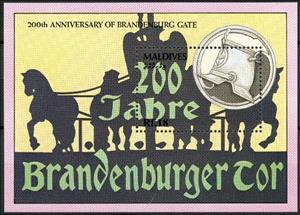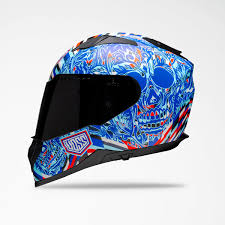Souvenir Sheet: Shako Helmet (Maldives 1992)
Shako Helmet (Maldives 1992)
29 January (Maldives ) within release Brandenburg Gate, 200th Anniversary (1992) goes into circulation Souvenir Sheet Shako Helmet face value 18 Maldivian rufiyaa
| Souvenir Sheet Shako Helmet in catalogues | |
|---|---|
| Michel: | Mi: MV BL211 |
| Yvert et Tellier: | Yt: MV BF203 |
| Stanley Gibbons: | Sg: MV MS1599c |
Souvenir Sheet is horizontal format.
Also in the issue Brandenburg Gate, 200th Anniversary (1992):
- Stamp - The 200th Anniversary of the Brandenburg Gate face value 20;
- Stamp - Helmet face value 18;
- Stamp - Helmet 1939 face value 18;
- Stamp - Studded helmet face value 18;
- Stamp - World War, Iron Cross face value 15;
- Souvenir Sheet - Helmet 1939 face value 18;
- Souvenir Sheet - Shako Helmet face value 18;
Souvenir Sheet Shako Helmet it reflects the thematic directions:
An anniversary is the date on which an event took place or an institution was founded in a previous year, and may also refer to the commemoration or celebration of that event. For example, the first event is the initial occurrence or, if planned, the inaugural of the event. One year later would be the first anniversary of that event. The word was first used for Catholic feasts to commemorate saints. Most countries celebrate national anniversaries, typically called national days. These could be the date of independence of the nation or the adoption of a new constitution or form of government. The important dates in a sitting monarch's reign may also be commemorated, an event often referred to as a "Jubilee".
A helmet is a form of protective gear worn to protect the head. More specifically, a helmet complements the skull in protecting the human brain. Ceremonial or symbolic helmets (e.g., a policeman's helmet in the United Kingdom) without protective function are sometimes worn. Soldiers wear combat helmets, often made from Kevlar or other lightweight synthetic fibers.
The horse (Equus ferus caballus) is one of two extant subspecies of Equus ferus. It is an odd-toed ungulate mammal belonging to the taxonomic family Equidae. The horse has evolved over the past 45 to 55 million years from a small multi-toed creature, Eohippus, into the large, single-toed animal of today. Humans began to domesticate horses around 4000 BC, and their domestication is believed to have been widespread by 3000 BC. Horses in the subspecies caballus are domesticated, although some domesticated populations live in the wild as feral horses. These feral populations are not true wild horses, as this term is used to describe horses that have never been domesticated, such as the endangered Przewalski's horse, a separate subspecies, and the only remaining true wild horse. There is an extensive, specialized vocabulary used to describe equine-related concepts, covering everything from anatomy to life stages, size, colors, markings, breeds, locomotion, and behavior.
A monument is a type of structure that was explicitly created to commemorate a person or event, or which has become relevant to a social group as a part of their remembrance of historic times or cultural heritage, due to its artistic, historical, political, technical or architectural importance. Examples of monuments include statues, (war) memorials, historical buildings, archaeological sites, and cultural assets. If there is a public interest in its preservation, a monument can for example be listed as a UNESCO World Heritage Site. The Palgrave Encyclopedia of Cultural Heritage and Conflict gives the next definition of monument:




